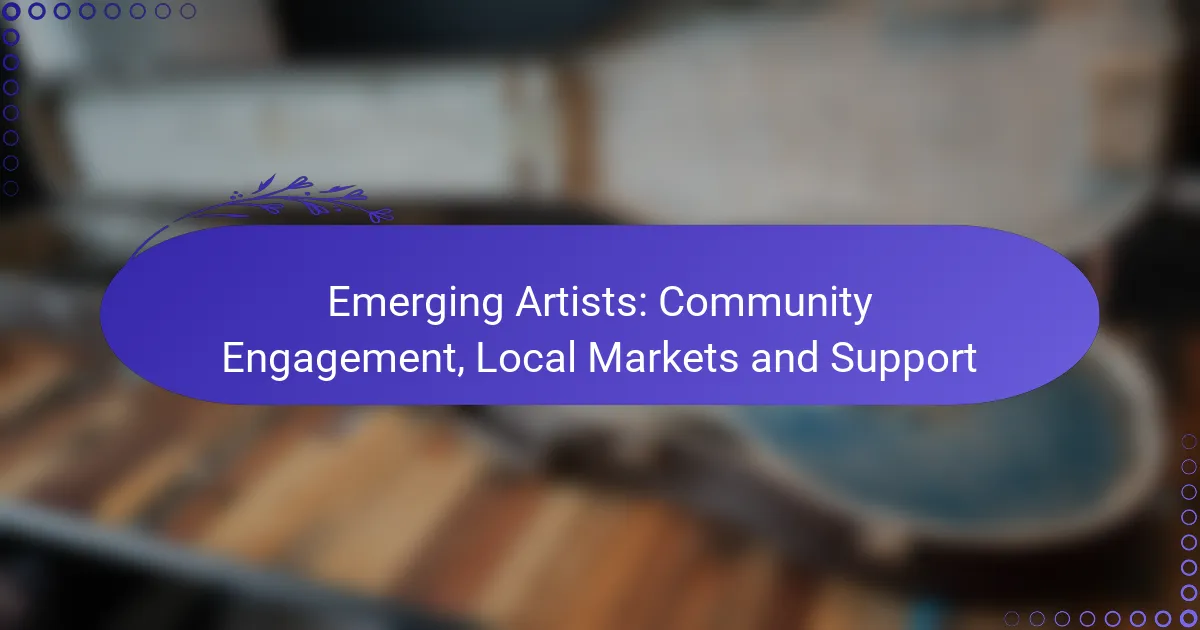Emerging artists play a vital role in enriching local communities through active engagement and collaboration. By participating in local markets and events, they gain visibility and create supportive networks that can lead to new opportunities. These platforms not only facilitate sales but also foster meaningful connections between artists and their audiences, enhancing the cultural fabric of the community.
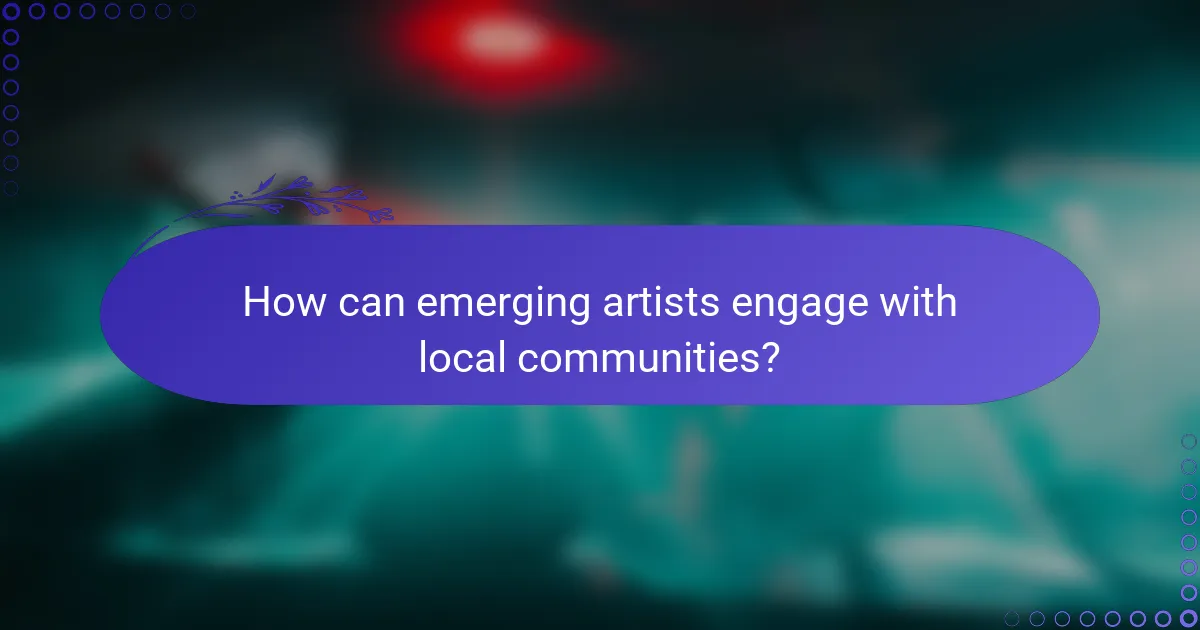
How can emerging artists engage with local communities?
Emerging artists can engage with local communities by participating in activities that foster connection and collaboration. These interactions not only enhance visibility but also build supportive networks that can lead to further opportunities.
Community workshops
Community workshops allow emerging artists to share their skills and knowledge with local residents. These hands-on sessions can cover various topics, such as painting, sculpture, or digital art, and typically last a few hours to a full day.
To organize a successful workshop, artists should consider the venue, materials needed, and the target audience. Collaborating with local community centers or schools can help attract participants and provide necessary resources.
Collaborative art projects
Collaborative art projects bring together artists and community members to create something unique. These projects can range from murals to community gardens, encouraging teamwork and fostering a sense of ownership among participants.
When planning a collaborative project, artists should outline clear goals, timelines, and roles for each participant. Securing funding through local grants or sponsorships can also enhance the project’s reach and impact.
Local exhibitions
Local exhibitions showcase the work of emerging artists while providing a platform for community engagement. These events can be held in galleries, cafes, or public spaces, allowing artists to connect with local audiences.
To maximize attendance, artists should promote their exhibitions through local media, social networks, and community bulletin boards. Offering interactive elements, such as artist talks or Q&A sessions, can further engage visitors and encourage dialogue.
Social media campaigns
Social media campaigns are an effective way for emerging artists to reach a broader audience and engage with their local community. Platforms like Instagram and Facebook allow artists to share their work, promote events, and connect with followers in real-time.
Artists should create a content calendar to maintain a consistent posting schedule and use relevant hashtags to increase visibility. Engaging with followers through comments and direct messages can also foster a sense of community and support.
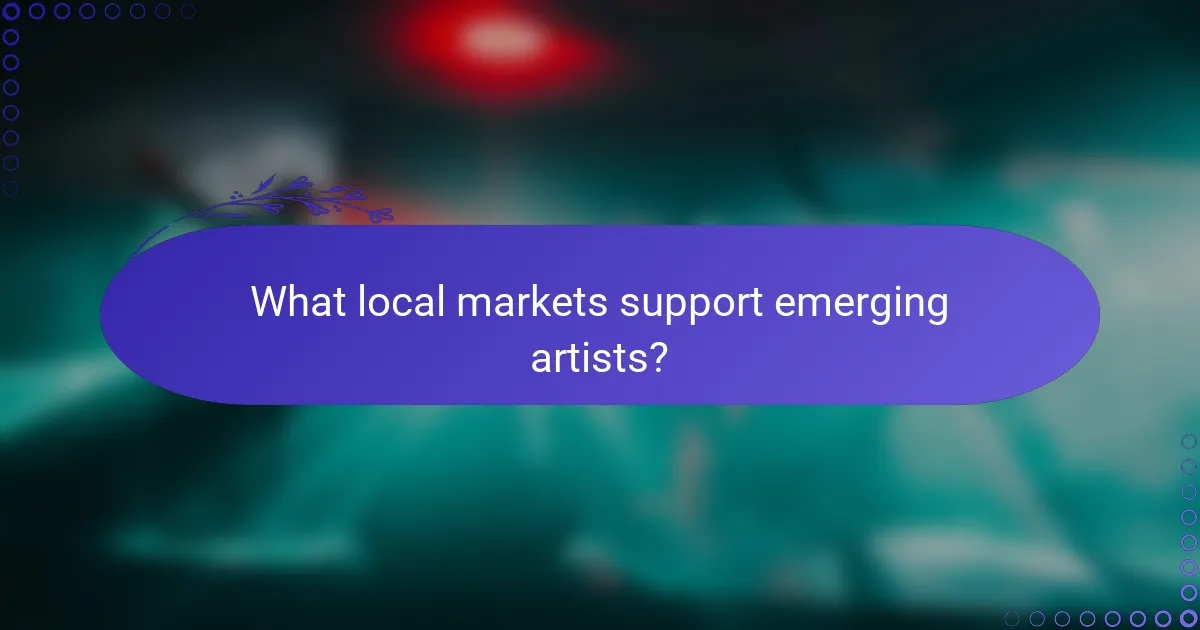
What local markets support emerging artists?
Local markets play a crucial role in supporting emerging artists by providing platforms for visibility, sales, and community engagement. These markets often include art fairs, farmers markets, and pop-up galleries, each offering unique opportunities for artists to connect with their audience and sell their work.
Art fairs in New York
Art fairs in New York serve as vibrant hubs for emerging artists to showcase their work to a diverse audience. Events like the Affordable Art Fair and the Armory Show attract collectors, curators, and art enthusiasts, providing artists with invaluable exposure.
Participating in these fairs often requires an application process and a fee, but the potential for sales and networking can be significant. Artists should prepare a strong portfolio and consider collaborating with local galleries to enhance their visibility.
Farmers markets in Los Angeles
Farmers markets in Los Angeles are not just for fresh produce; they also feature local artists selling handmade goods and artwork. Markets like the Hollywood Farmers Market allow artists to set up booths, reaching a community-focused audience that appreciates local craftsmanship.
Artists should check for vendor application requirements and fees, which can vary by market. Engaging with customers directly can lead to sales and commissions, making it a worthwhile investment for emerging artists.
Pop-up galleries in Chicago
Pop-up galleries in Chicago offer flexible, temporary spaces for emerging artists to display their work in unique settings. These galleries often emerge in vacant storefronts or community spaces, allowing artists to experiment with their presentations and reach new audiences.
To participate, artists should seek out local organizations or collectives that host pop-up events. Collaborating with other artists can also help share costs and attract a larger crowd, enhancing the overall experience for both the artists and attendees.
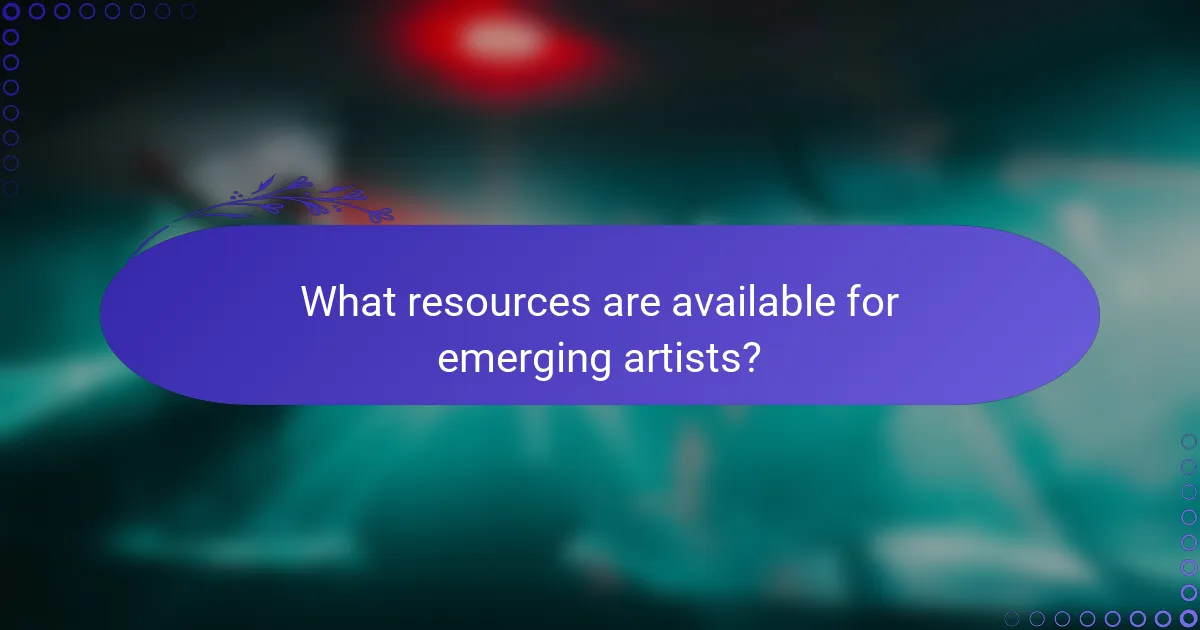
What resources are available for emerging artists?
Emerging artists can access various resources to support their careers, including grants, local collectives, and online platforms. These resources provide financial assistance, community connections, and avenues for audience engagement.
Grants from the National Endowment for the Arts
The National Endowment for the Arts (NEA) offers grants specifically designed to support emerging artists in various disciplines. These grants can range from a few thousand to tens of thousands of dollars, depending on the project and funding category.
To apply, artists must submit a proposal outlining their project, budget, and expected outcomes. It’s crucial to adhere to the NEA’s guidelines and deadlines, as competition can be intense.
Local artist collectives
Joining local artist collectives can provide emerging artists with valuable networking opportunities and resources. These collectives often host workshops, exhibitions, and collaborative projects that foster community engagement and skill development.
Artists should research collectives in their area, attend meetings, and actively participate in events to maximize their involvement. Being part of a collective can also lead to shared resources, such as studio space or promotional support.
Online platforms like Patreon
Online platforms like Patreon allow emerging artists to monetize their work directly through fan subscriptions. Artists can offer exclusive content, behind-the-scenes access, or personalized rewards to their supporters, creating a sustainable income stream.
Setting up a Patreon account is straightforward, but artists should focus on building a strong online presence and engaging with their audience. Regular updates and transparent communication can help maintain and grow their subscriber base.

How do local businesses contribute to artist support?
Local businesses play a crucial role in supporting artists by providing financial backing, promoting visibility, and fostering community engagement. Their involvement can enhance the local art scene and create mutually beneficial relationships between artists and the business community.
Sponsorship of art events
Local businesses often sponsor art events, such as gallery openings, festivals, or workshops, which can significantly boost an artist’s exposure. Sponsorship can include financial contributions, in-kind donations, or promotional support, helping to cover costs and attract larger audiences.
For example, a local café might sponsor a monthly art night, providing space and refreshments while showcasing local talent. This not only elevates the artist’s profile but also draws customers to the business, creating a win-win situation.
Displaying local art in storefronts
Displaying local art in storefronts is another effective way for businesses to support artists. By showcasing artwork in their windows or interior spaces, businesses can enhance their aesthetic appeal while giving artists a platform to reach potential buyers.
Many businesses adopt a rotating display system, featuring different artists each month. This approach keeps the environment fresh and encourages community members to visit regularly, fostering a sense of local pride and support for the arts.

What role do social media platforms play in artist promotion?
Social media platforms are essential for artist promotion, providing a space for exposure, engagement, and community interaction. They allow artists to showcase their work, connect with audiences, and build a personal brand without significant financial investment.
Instagram for visual storytelling
Instagram is a powerful tool for visual storytelling, enabling artists to share their creations through images and videos. With features like Stories and Reels, artists can engage followers with behind-the-scenes content, process videos, and finished pieces, creating a narrative around their work.
To maximize impact, artists should use relevant hashtags and geotags to reach wider audiences. Posting consistently and engaging with followers through comments and direct messages can foster a loyal community. For example, artists can host live Q&A sessions to discuss their work and creative process.
Facebook groups for community building
Facebook groups serve as a platform for community building, allowing artists to connect with like-minded individuals and potential fans. These groups can be niche-focused, catering to specific art forms or local markets, which enhances targeted engagement.
Artists should actively participate in discussions, share their work, and provide feedback to others in the group. This reciprocal interaction not only builds relationships but also increases visibility. For instance, local artists can collaborate on projects or events, leveraging the group to promote their collective work.
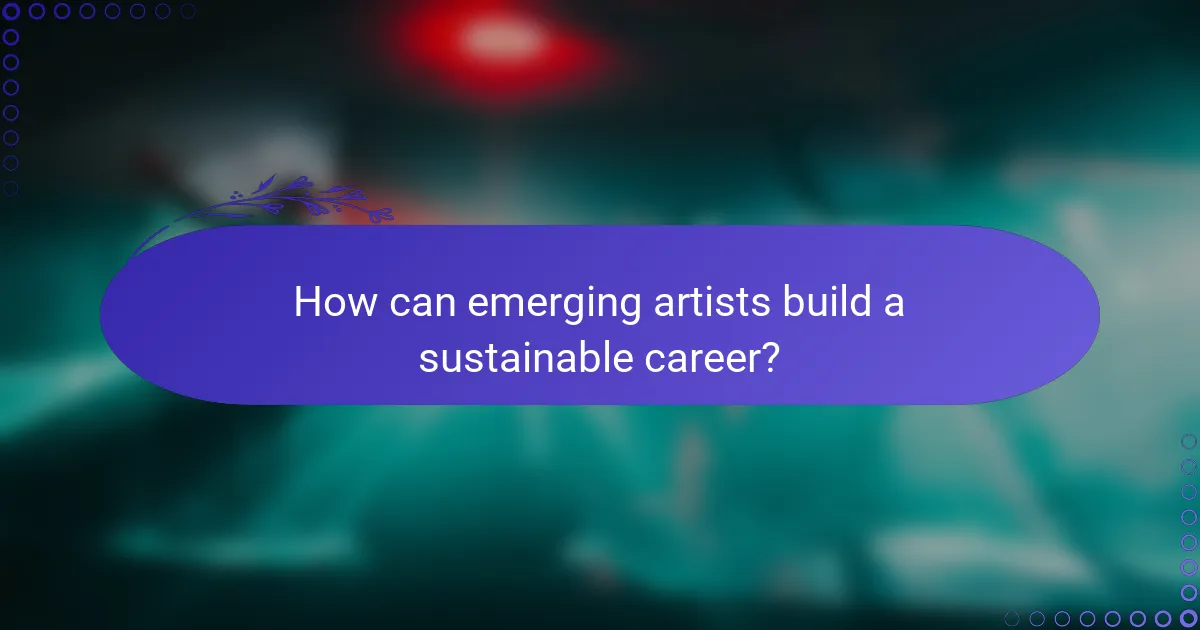
How can emerging artists build a sustainable career?
Emerging artists can build a sustainable career by diversifying their income sources and actively networking with established artists. These strategies not only enhance financial stability but also foster valuable connections within the art community.
Diversifying income streams
Diversifying income streams is crucial for emerging artists to achieve financial stability. This can include selling original artwork, prints, and merchandise, as well as offering workshops or online courses. Artists may also consider licensing their work for various media, which can provide passive income.
Additionally, participating in local markets and art fairs can help artists reach new audiences and generate sales. Artists should aim to have multiple income sources, as relying solely on one can be risky, especially in fluctuating markets.
Networking with established artists
Networking with established artists is essential for emerging artists seeking to grow their careers. Building relationships can lead to mentorship opportunities, collaborative projects, and exposure to new audiences. Attending gallery openings, art shows, and community events can facilitate these connections.
Emerging artists should also consider joining local art organizations or online communities where they can meet and engage with more experienced peers. These interactions can provide insights into industry best practices and help artists navigate challenges in their careers.
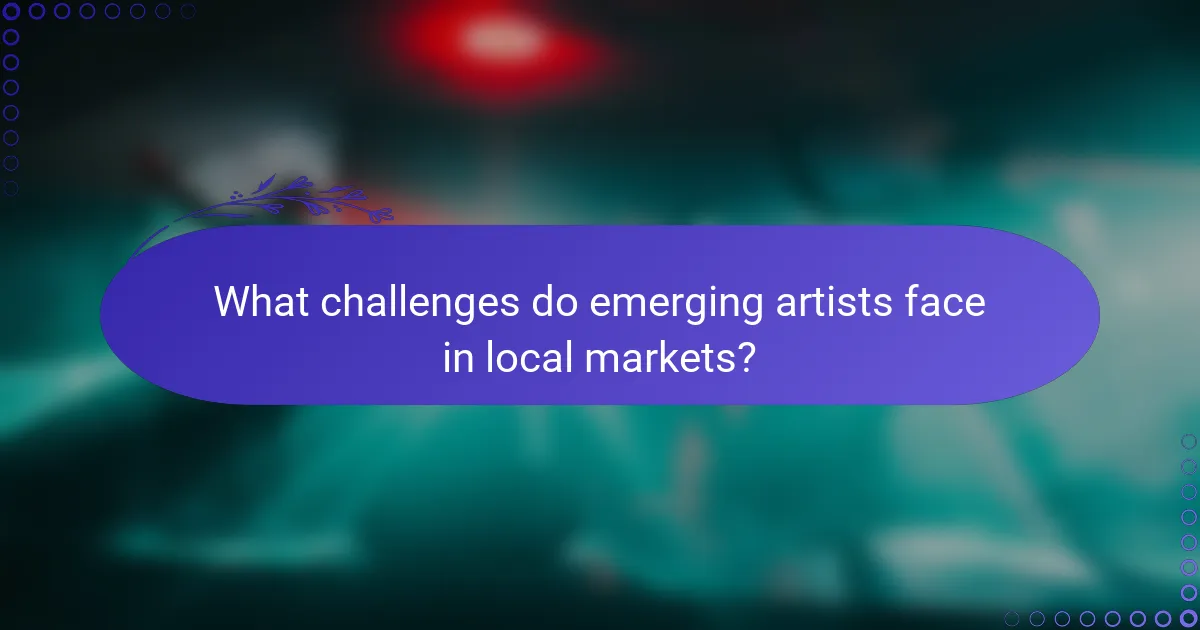
What challenges do emerging artists face in local markets?
Emerging artists often encounter significant challenges in local markets, including limited visibility, financial instability, and difficulty in accessing resources. These obstacles can hinder their ability to establish a sustainable career and connect with potential audiences.
Limited visibility and exposure
Many emerging artists struggle to gain visibility in crowded local markets where established artists dominate. Without effective marketing strategies, their work may go unnoticed, making it essential to leverage social media and community events to showcase their art.
Participating in local exhibitions, art fairs, and open studios can enhance exposure. Collaborating with local businesses or community organizations can also create opportunities for visibility and engagement with a broader audience.
Financial instability
Financial challenges are prevalent among emerging artists, as they often lack a steady income stream. Many rely on part-time jobs to support their artistic endeavors, which can limit the time and energy they can dedicate to their craft.
To mitigate financial instability, artists should consider diversifying their income sources. This can include selling artwork online, offering workshops, or applying for grants and funding opportunities available in their region.
Access to resources and support
Emerging artists frequently face barriers in accessing essential resources such as studio space, materials, and mentorship. Limited funding and high costs can make it difficult to acquire the tools needed for their artistic practice.
Building a network within the local arts community can provide valuable support and resources. Artists should seek mentorship programs, artist collectives, or local arts organizations that offer grants or subsidized studio space to help overcome these challenges.
